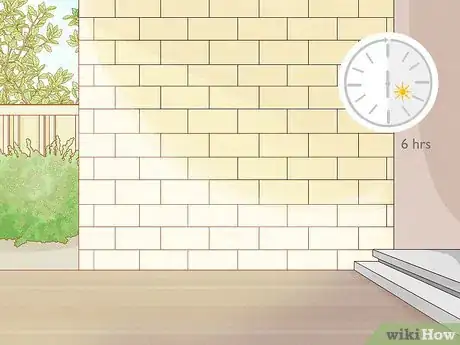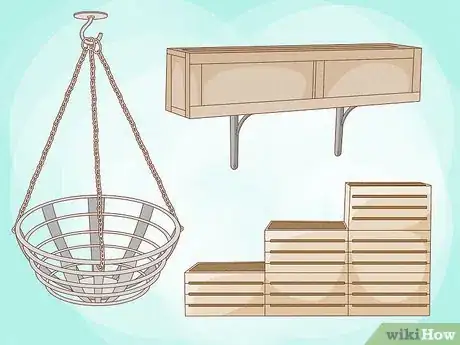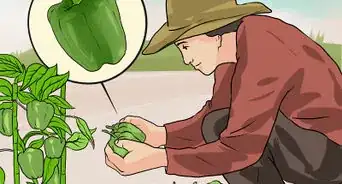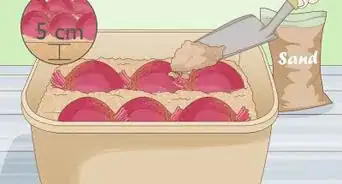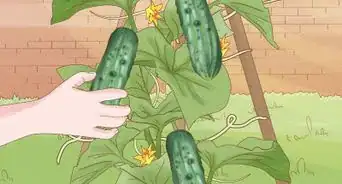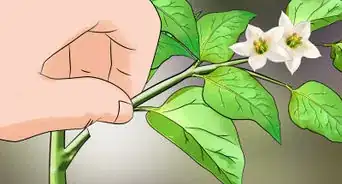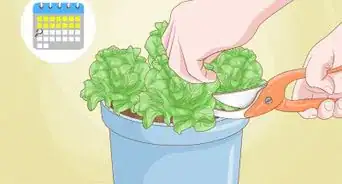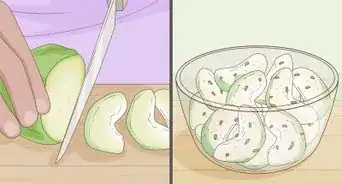This article was co-authored by Monique Capanelli. Monique Capanelli is a Plant Specialist and the Owner and Designer for Articulture Designs, an innovative design firm and boutique in Austin, Texas. With over 15 years of experience, Monique specializes in interior botanical design, living walls, event decor, and sustainable landscape design. She attended the University of Texas at Austin. Monique is a Certified Permaculture Designer. She provides plant and botanical design experiences, from small gifts to entire transformations, to shoppers as well as commercial clients including Whole Foods Market and The Four Seasons.
wikiHow marks an article as reader-approved once it receives enough positive feedback. In this case, 87% of readers who voted found the article helpful, earning it our reader-approved status.
This article has been viewed 98,099 times.
Vertical gardening is an approach used to grow vegetables up and down, rather than side to side like in a traditional horizontal garden. In a vertical garden, vegetables grow up tall structures instead of across the ground. Vertical gardening is an alternative for gardeners with limited space. Through vertical gardening, you also can obstruct undesirable views or create an area of architectural interest. Use these tips to grow vegetables vertically.
Steps
Preparing a Vertical Garden
-
1Determine where to situate the vertical garden. Most vegetables require at least 6 hours of sun, so choose a sunny location for the vertical garden. If you live in an apartment building, a sunny balcony may be an option. If you have a yard, consider a sunny location against a south-facing wall of your house.[1]
-
2Select vertical structures. In order for plants to grow vertically, they need a vertical support system. Common support structures include trellises, tripods, pyramids, walls, fences, wire cages and walls. Arches or arbors can serve as focal areas while also supporting vegetables. Almost any structure that points toward the sky can be used for vertical gardening. Consider creative options like bamboo poles, tree branches, ladders, sunflowers or corn stalks.[2]
- Choose a support structure strong enough for the vegetables you want to grow. Mature plants loaded down with vegetables can be heavy. For example, tomato plants require very sturdy vertical structures, while peas may climb almost any structure without bearing much weight on it.
- Place the support system in your garden or on your patio before planting vegetables. This prevents you from damaging plants.
- Locate vertical supports on the north or east side of the garden where they won't block the sun from the growing vegetables.
- Anchor the support system securely. Vertical supports like trellises or wire cages can be staked directly in the ground. Trellises and other flat vertical supports also can be attached to the exterior wall of a home. If you attach a vertical support to a wall, leave space between the wall and the trellis for air circulation as the plant climbs.
Advertisement -
3Prepare the soil. Whether you plant vegetables in the ground or in containers, soil quality is important for your vertical garden. Use weed-free, compost-rich soil. To encourage proper drainage in containers, mix the soil with peat moss or perlite.[3]
-
4Choose containers as applicable. If you are growing vegetables in containers, you can use almost any type of container. Make sure that the container is deep enough to accommodate the type of vegetable you are growing. Larger and heavier vegetables will require larger and sturdier containers. Consider hanging baskets, urns, window boxes, washtubs, coffee cans, clay pots or wooden crates. If the container does not have drainage holes, drill small holes on the bottom of the container before filling it with soil.
Growing Vegetables Vertically
-
1Understand the basics of growing vegetables vertically. Almost any type of vegetable can be grown vertically as long as the container is deep enough to accommodate the plant and the vertical staking is strong enough to hold the plant.
- Evaluate your garden conditions. Choose vegetables that will thrive in your garden based on its lights, wind, heat and moisture. If you are growing vertical vegetables in containers, be prepared to water the containers daily.
- Plant the "vine" varieties of plants when applicable. If you are growing beans, cucumbers, squash or beans, be sure to plant the vine variety, which will climb vertically, instead of the bush variety.
-
2Select vegetables to grow. While most vegetables can be grown vertically, several types of vegetables are known for their success in vertical gardens. If you are just starting out in vertically gardening, consider these vegetables.[4]
- Grow pole beans vertically. Pole beans will climb almost any structure, including other plants. The Native Americans often planted beans and corn together because the corn would provide a vertical support for the beans.
- Grow peas in a vertical garden. Like pole beans, peas will climb almost any structure and need little encouragement to twine around vertical supports. Consider growing peas on trellises, bamboo sticks or even over an arbor.
- Grow winter squash and gourds vertically. Winter squash and gourds have long vines that can extend up to 10 feet (3.0 m) for the squash and 25 feet (7.6 m) for the gourds. Because the vines grow so long and become heavy, you must provide a sturdy, secure vertical support. To provide extra support to heavy winter squash, such as butternut, wrap cloth twine or strips of pantyhose around each fruit and tie to the vertical supporting structure. Do not use string to support the squash because it may cut into the stems. Some garden centers sell materials made specifically for supporting large vegetables, like winter squash and gourds.
- Grow melons and pumpkins in a vertical garden. Like winter squash, melons and pumpkins have long vines and the fruit needs additional support when growing vertically. Grow melons and pumpkins up strong, secure vertical structures. Wrap slings made of old sheets, rags, towels or fabric scraps around the melons and pumpkins and secure them to the fence or trellis to provide needed support.
- Grow cucumbers vertically. Cucumbers (the vine variety, not the bush variety) are ideal for a vertical garden because they naturally climb. They can be grown up almost any structure, such as an A-frame, cage or trellis, but it must be strong enough to support the weight of the vines. Initially, cucumbers may need a little encouragement to attach themselves to the vertical structure, but as soon as the tendrils wind around the support, they will climb vertically without assistance. The cucumbers will hang vertically from the plant, making them easy to harvest.
- Grow tomatoes in a vertical garden. Because tomatoes are heavy plants, they require a sturdy vertical structure. As the tomato plants grow, tie the branches to the structure with a soft twine or cotton cloth at regular intervals.
Expert Q&A
-
QuestionWhat is a tower garden and what are the most important steps to build a tower garden?
 Monique CapanelliMonique Capanelli is a Plant Specialist and the Owner and Designer for Articulture Designs, an innovative design firm and boutique in Austin, Texas. With over 15 years of experience, Monique specializes in interior botanical design, living walls, event decor, and sustainable landscape design. She attended the University of Texas at Austin. Monique is a Certified Permaculture Designer. She provides plant and botanical design experiences, from small gifts to entire transformations, to shoppers as well as commercial clients including Whole Foods Market and The Four Seasons.
Monique CapanelliMonique Capanelli is a Plant Specialist and the Owner and Designer for Articulture Designs, an innovative design firm and boutique in Austin, Texas. With over 15 years of experience, Monique specializes in interior botanical design, living walls, event decor, and sustainable landscape design. She attended the University of Texas at Austin. Monique is a Certified Permaculture Designer. She provides plant and botanical design experiences, from small gifts to entire transformations, to shoppers as well as commercial clients including Whole Foods Market and The Four Seasons.
Plant Specialist A tower garden means growing vertically in columns. There are many different ways to build a tower garden. There are lots of pre-made PVC molded cases that are on the market. If you want to DIY it, try to find something that is already a hollow cylinder, like a large eight-inch diameter PVC pipe, which you can probably get from a garden store or a plumbing store. You can then drill or cut out pockets in these columns. Next, stuff it with soil. Good, airy soil is important because in a column you have gravity compaction and you don't want that bottom level of planting to get suffocated. Then, plant plants that are going to really flourish. Tomatoes do great in a tower garden. A lot of annual flowers like Johnny Jump Up do great and cover the column over time.
A tower garden means growing vertically in columns. There are many different ways to build a tower garden. There are lots of pre-made PVC molded cases that are on the market. If you want to DIY it, try to find something that is already a hollow cylinder, like a large eight-inch diameter PVC pipe, which you can probably get from a garden store or a plumbing store. You can then drill or cut out pockets in these columns. Next, stuff it with soil. Good, airy soil is important because in a column you have gravity compaction and you don't want that bottom level of planting to get suffocated. Then, plant plants that are going to really flourish. Tomatoes do great in a tower garden. A lot of annual flowers like Johnny Jump Up do great and cover the column over time. -
QuestionI want to know more about the soil and nutrient media used in a vertical garden.
 Community AnswerAny lightweight potting media works well. Use landscape fabric to hold soil in places where it may fall or leak out.
Community AnswerAny lightweight potting media works well. Use landscape fabric to hold soil in places where it may fall or leak out.
Warnings
- Do not pull fruits or vegetables like cucumbers, melons or squash off of the vertically growing vines. Pulling the fruits or vegetables too hard may separate the vine from its vertical structure or uproot it. Rather, use a small knife or pruning shears to remove fruits and vegetables from the vine.⧼thumbs_response⧽
- The climbing vines of many vegetables can have sharp, prickly edges. To protect your hands, wear garden gloves when harvesting vegetables.⧼thumbs_response⧽
Things You'll Need
- Vertical support structures
- Vegetable seeds or seedlings
- Compost-rich soil
- Peat moss or perlite
- Containers
- Water
- Cloth twine or strips of fabric
- Old sheets, rags, towels or fabric
- Garden gloves
- Small knife or pruning shears
References
About This Article
Vertical gardening is a great alternative if you have limited space. To begin your vertical garden, select a support, like a trellis, fence, or wire cage. Anchor the support by staking it into the ground or attaching it to an exterior wall of your home. Then, fill containers, like hanging baskets, window boxes, or wooden crates, with soil and plant your vegetables in them. Any kind of vegetable will work for a vertical garden, but you could try starting with pole beans, peas, cucumbers, and tomatoes since they grow well on vertical structures. Once you've planted your vegetables, attach the containers to the vertical structure and tend to them like you would with a regular potted vegetable garden. To learn how to prepare the soil for your vertical garden, keep reading!
